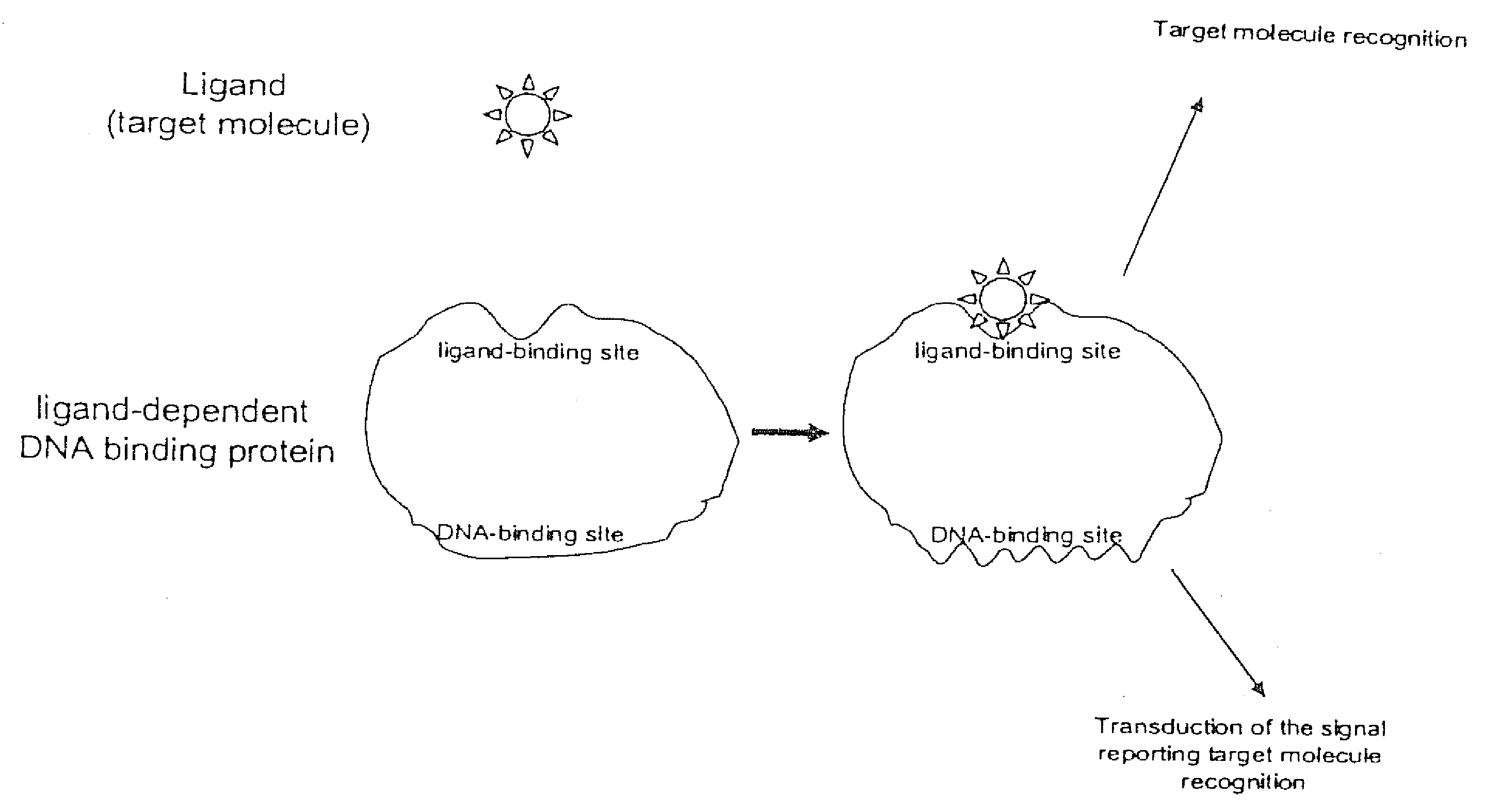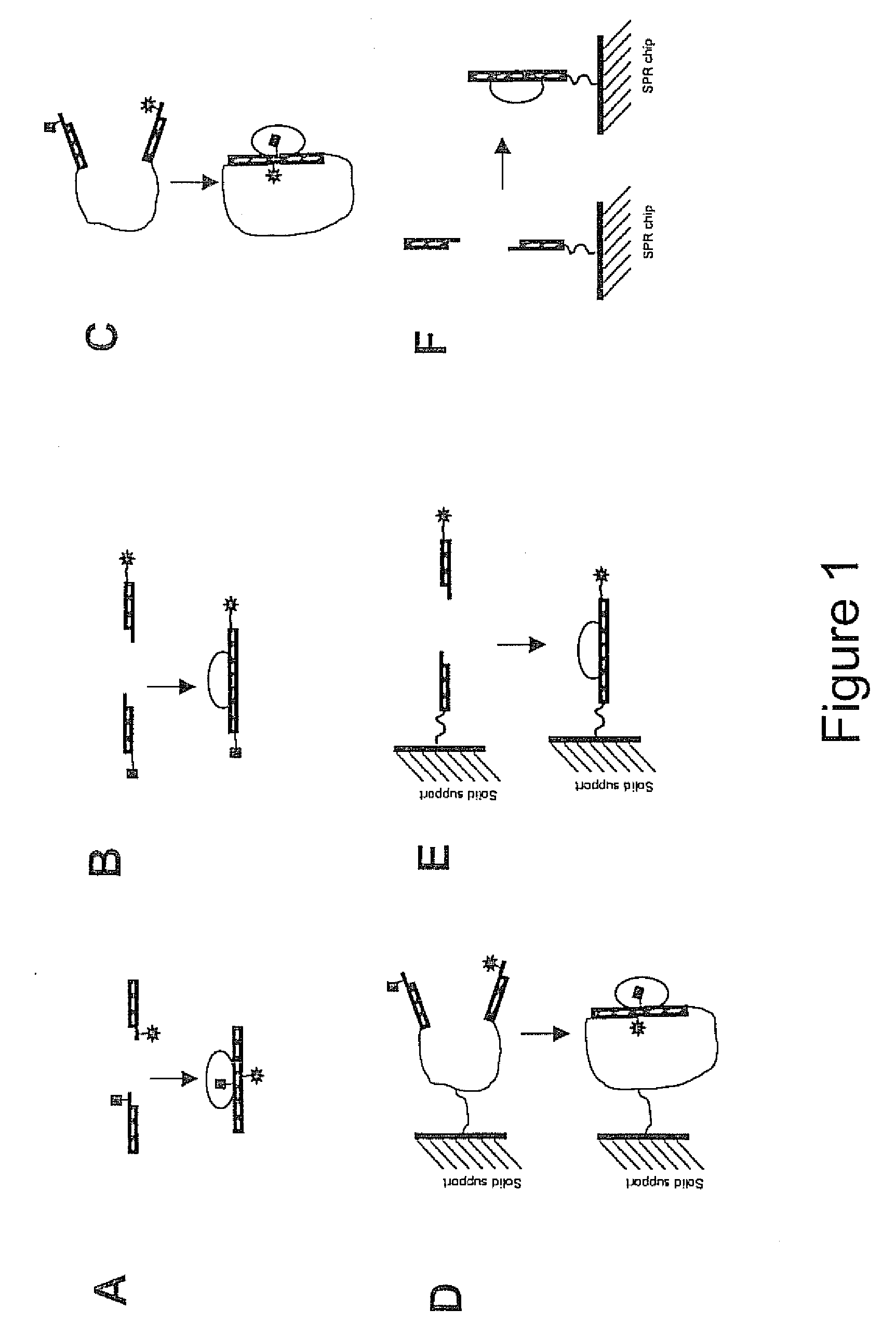Rapid and sensitive assay for the detection and quantification of coregulators of nucleic acid binding factors
a nucleic acid binding factor and coregulator technology, applied in the field of biosensors, can solve the problems of laborious and time-consuming methods, and the general adaptability of methods to high-throughput assay formats, and achieve the effect of facilitating or stabilizing the spectroscopic interaction and measurable changes in fluorescen
- Summary
- Abstract
- Description
- Claims
- Application Information
AI Technical Summary
Benefits of technology
Problems solved by technology
Method used
Image
Examples
example 1
Detection of cAMP Receptor Protein (CAP), a Sequence-Specific Nucleic Acid Binding Protein from E. coli
[0123] CAP is a bacterial transcription activator which binds DNA at a Kd=˜0.1 nM in a sequence specific manner (Busby, S., and Ebright, R. H. J. Mol. Biol. 293, 199-213, 1999). A 38 bp DNA sequence corresponding to a consensus CAP site (Ebright, R. H., Ebright, Y. W. & Gunasakera, A. Nucleic Acids Res. 17, 10295-10305, 1989) was used as a basis for designing oligonucleotides necessary for preparing the CAP assay reagents according to the scheme illustrated in FIG. 1A. FIG. 3 illustrates the details of the design used. The following four oligonucleotides were synthesized using standard phosphoramidate automated oligonucleotide synthesis (F=dT-fluorescein; D=dT-dabcyl):
5′-AACGCAATAAATGTGA(CAP1; SEQ ID NO:1)5′-AGFAGATCACATTTTAGGCACC 3′(CAP2; SEQ ID NO:2)5′-GGTGCCTAAAATGTGA(CAP3; SEQ ID NO:3)5′-TCDACTTCACATTTATTGCGTT(CAP4; SEQ ID NO:4)
[0124] The fluorescence donor (fluorescein) and...
example 2
Demonstration of the Use of Fluorochromes with Different Emission Spectra and Different Modes of Fluorescence Signal Detection
[0131] The following oligonucleotides, which have identical sequences to CAP2 and CAP4, respectively, were synthesized using standard phosphoramidate automated oligonucleotide synthesis, wherein X represents amino-dT:
5′-AGXAGATCACATTTTAGGCACC-3′(CAPS; SEQ ID NO:7)5′-TCXACTTCACATTTATTGCGTT-3′(GAPS; SEQ ID NO:8)
[0132] Amino-Modifier C2 dT (Glen Research, Sterling, Va.) was incorporated into positions that are equivalent to the positions at which fluorescein-dt and dabcyl-dT has been used previously in CAP2 and CAP4 oligonucleotides, respectively. Amino-Modifier C2 dT contains a reactive aliphatic amino group that can be used to covalently attach any aminoreactive fluorescence probe. CAP5 (SEQ ID NO:7) and CAP6 (SEQ ID NO:8) oligonucleotides were modified with 7-diethylaminocoumarin-3-carboxylic acid, succinimidyl ester. This fluorochrome is excited at 433 nm...
example 3
The Detection of Nucleic Acid Binding Protein Coregulators, for Example cAMP
[0135] The activity of many nucleic acid binding proteins is regulated by small molecules, other proteins or cellular events (e.g., phosphorylation). Hence, the present invention may be used to identify or detect these regulatory molecules or regulatory cellular events.
[0136] CAP protein binds both cAMP and cGMP with micromolar affinity (Takahashi, M., Blazy, B., and Baudras, A. Biochemistry 19, 5124-30). Thus, CAP protein, by itself, is a poor reagent for specifically detecting cAMP. However, the high affinity of CAP for its cognate nucleic acid binding sequence is selectively dependent on cAMP, but not cGMP. Since only cAMP is thermodynamically linked to sequence-specific nucleic acid binding, in the presence of DNA containing a CAP binding site, the affinity of CAP for cAMP is increased about 1000-fold, whereas the affinity for cGMP remains unchanged. Thus, in the presence of DNA containing a CAP bindin...
PUM
| Property | Measurement | Unit |
|---|---|---|
| excitation wavelength | aaaaa | aaaaa |
| excitation wavelength | aaaaa | aaaaa |
| excitation wavelength | aaaaa | aaaaa |
Abstract
Description
Claims
Application Information
 Login to View More
Login to View More - R&D
- Intellectual Property
- Life Sciences
- Materials
- Tech Scout
- Unparalleled Data Quality
- Higher Quality Content
- 60% Fewer Hallucinations
Browse by: Latest US Patents, China's latest patents, Technical Efficacy Thesaurus, Application Domain, Technology Topic, Popular Technical Reports.
© 2025 PatSnap. All rights reserved.Legal|Privacy policy|Modern Slavery Act Transparency Statement|Sitemap|About US| Contact US: help@patsnap.com



